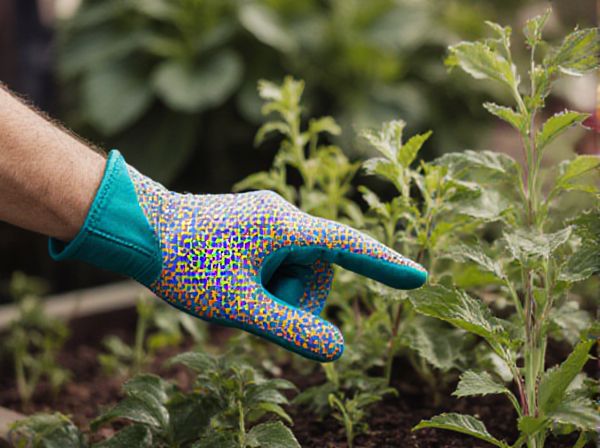
Mosaic virus vs Leaf curl virus Illustration
Mosaic virus causes distinctive mottled patterns and discoloration on leaves, leading to reduced photosynthesis and stunted plant growth, while Leaf curl virus primarily induces leaf curling, thickening, and distortion, severely affecting the plant's development. Both viruses are transmitted by insect vectors, such as aphids and whiteflies, and can significantly decrease crop yields if not managed properly. Effective control measures include the use of resistant plant varieties, proper sanitation, and vector control strategies to minimize virus spread.
Table of Comparison
| Feature | Mosaic Virus | Leaf Curl Virus |
|---|---|---|
| Virus Family | Tobamovirus, Potyvirus | Geminiviridae |
| Host Plants | Tobacco, tomatoes, cucumbers, beans | Tomatoes, cotton, okra, chili |
| Symptoms | Mottled or mosaic leaf patterns, yellowing, distortion | Leaf curling, leaf thickening, stunted growth |
| Transmission | Insect vectors (aphids), mechanical, seed-borne | Whiteflies (Bemisia tabaci) |
| Virus Particle | Rod-shaped or filamentous | Geminate (twinned) icosahedral particles |
| Genome Type | Single-stranded RNA (ssRNA) | Single-stranded DNA (ssDNA) |
| Control Methods | Resistant varieties, vector control, crop hygiene | Whitefly control, resistant varieties, removal of infected plants |
Overview of Mosaic Virus and Leaf Curl Virus
Mosaic virus primarily affects plants by causing mottled leaf patterns, stunted growth, and reduced yield, with common strains including Tobacco mosaic virus and Cucumber mosaic virus. Leaf curl virus is characterized by upward curling and yellowing of leaves, often linked to Begomovirus species transmitted by whiteflies. Both viruses significantly impact crop health, leading to economic losses in agriculture worldwide.
Key Differences Between Mosaic and Leaf Curl Viruses
Mosaic virus primarily causes mottled patterns of light and dark green on plant leaves by disrupting chlorophyll production, while Leaf curl virus induces severe leaf distortion and curling by targeting the plant's vascular system. Mosaic virus is often spread by aphids in a non-persistent manner, whereas Leaf curl virus transmission predominantly occurs through whitefly vectors in a persistent mode. The genetic makeup differs as Mosaic viruses belong mainly to the Potyviridae family, whereas Leaf curl viruses are typically part of the Geminiviridae family, impacting their host range and symptom expression.
Symptoms: Mosaic Virus vs Leaf Curl Virus
Mosaic virus causes mottled patterns of light and dark green on leaves, often accompanied by leaf distortion and stunted growth. Leaf curl virus leads to severe leaf curling, thickening, and yellowing, creating a characteristic upward rolling of the leaf margins. Both viruses reduce photosynthetic efficiency but differ in symptom manifestation and plant tissue damage.
Transmission and Spread Mechanisms
Mosaic virus primarily spreads through insect vectors such as aphids and whiteflies, facilitating rapid transmission between plants during feeding. Leaf curl virus is predominantly transmitted by the whitefly Bemisia tabaci, which acquires and spreads the virus in a persistent manner. Both viruses also propagate through infected plant material, enabling local and regional disease outbreaks.
Host Plants Susceptible to Each Virus
Mosaic virus primarily infects a wide range of host plants including cucumbers, tomatoes, peppers, and beans, causing characteristic mottled and distorted leaves that reduce photosynthesis efficacy. Leaf curl virus targets mainly solanaceous crops like tomatoes and peppers, leading to leaf curling, thickening, and stunted growth which severely impact fruit yield. Both viruses transmit through insect vectors such as whiteflies and aphids, with host plant susceptibility varying according to virus strain and environmental conditions.
Diagnosing Mosaic and Leaf Curl Infections
Accurate diagnosis of mosaic virus and leaf curl virus infections involves observing distinct symptoms such as mottled, mosaic-like patterns on leaves for mosaic virus and severe leaf curling with yellowing for leaf curl virus. Laboratory testing through serological assays like ELISA or molecular techniques such as PCR confirms the presence of specific viral genetic material. Early identification allows for effective management strategies to prevent widespread crop damage.
Prevention Strategies for Both Viruses
Effective prevention strategies for Mosaic virus and Leaf curl virus include using certified virus-free seeds and resistant crop varieties to minimize initial inoculum. Implementing strict vector control measures, such as managing whitefly populations through insecticides and reflective mulches, significantly reduces virus transmission. Crop rotation and removing infected plants promptly help limit the spread and persistence of both viruses in agricultural fields.
Treatment Options and Management Approaches
Mosaic virus management primarily involves using resistant plant varieties, implementing crop rotation, and controlling vector populations such as aphids through insecticides or biological agents. Leaf curl virus treatment focuses on eliminating infected plants, employing whitefly control measures via insecticides and reflective mulches, and adopting resistant cultivars. Both viruses benefit from integrated pest management strategies and good agricultural practices to minimize viral spread and crop damage.
Impact on Plant Growth and Yield
Mosaic virus causes mottled, distorted leaves which significantly reduce photosynthesis, leading to stunted plant growth and lower crop yields. Leaf curl virus induces severe leaf curling and thickening, disrupting nutrient transport and causing more drastic yield losses, often up to 70-90% in susceptible crops like tomatoes and cotton. Both viruses severely impair plant vigor, but Leaf curl virus typically results in more pronounced reductions in overall agricultural productivity.
Resistant Varieties and Future Research
Resistant varieties for Mosaic virus often include genetically engineered tomatoes and cucumbers exhibiting high tolerance due to specific gene insertions such as the Tm-22 gene, while Leaf curl virus resistance is predominantly found in certain tomato cultivars bred through marker-assisted selection targeting the Ty genes. Future research emphasizes CRISPR-Cas9 genome editing to enhance resistance mechanisms and the development of broad-spectrum antiviral compounds to mitigate viral replication in both Mosaic and Leaf curl virus infections. Advances in RNA interference technology also hold promise for durable resistance by silencing essential viral genes across diverse crop species.
Mosaic virus vs Leaf curl virus Infographic

 gardendif.com
gardendif.com